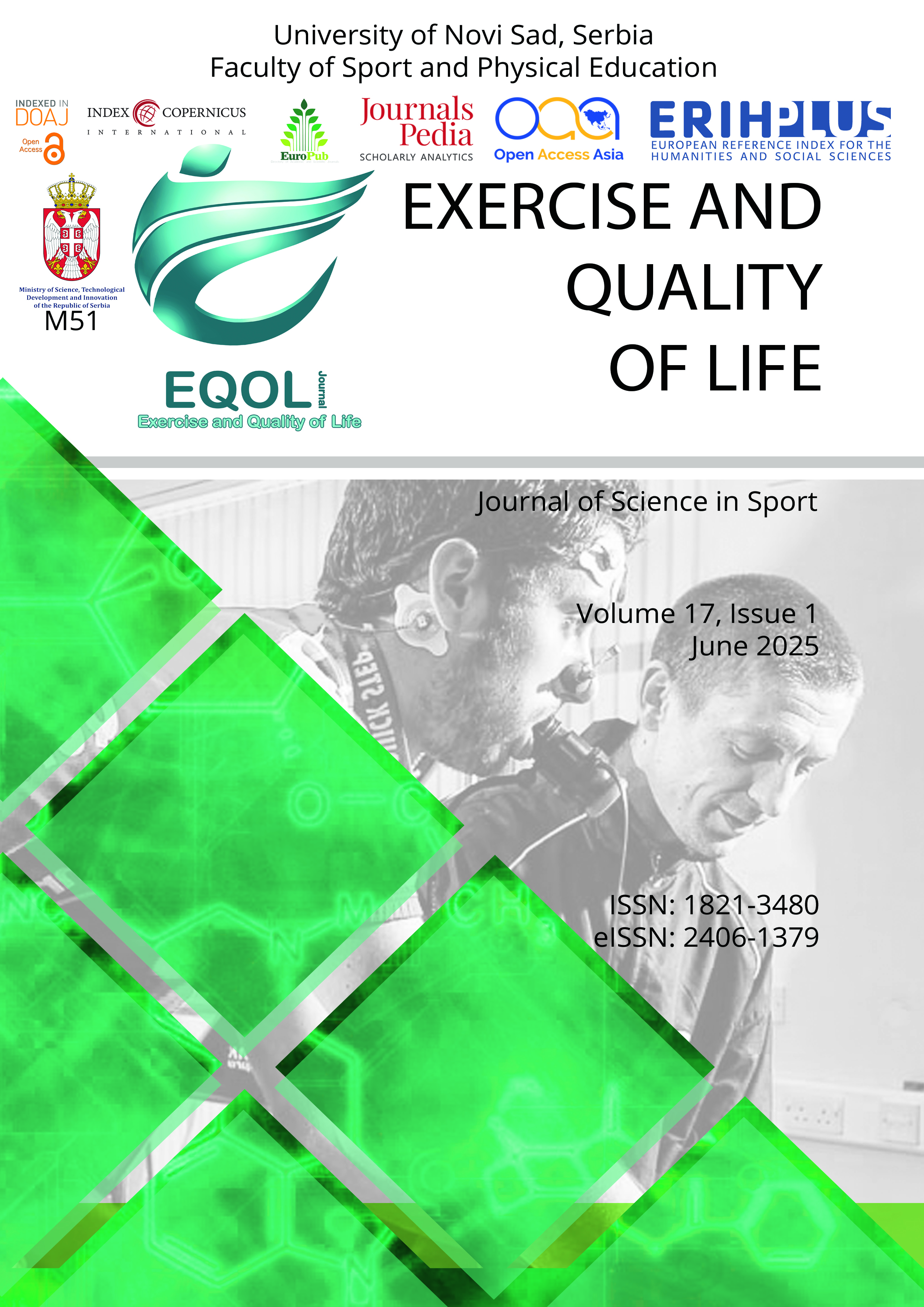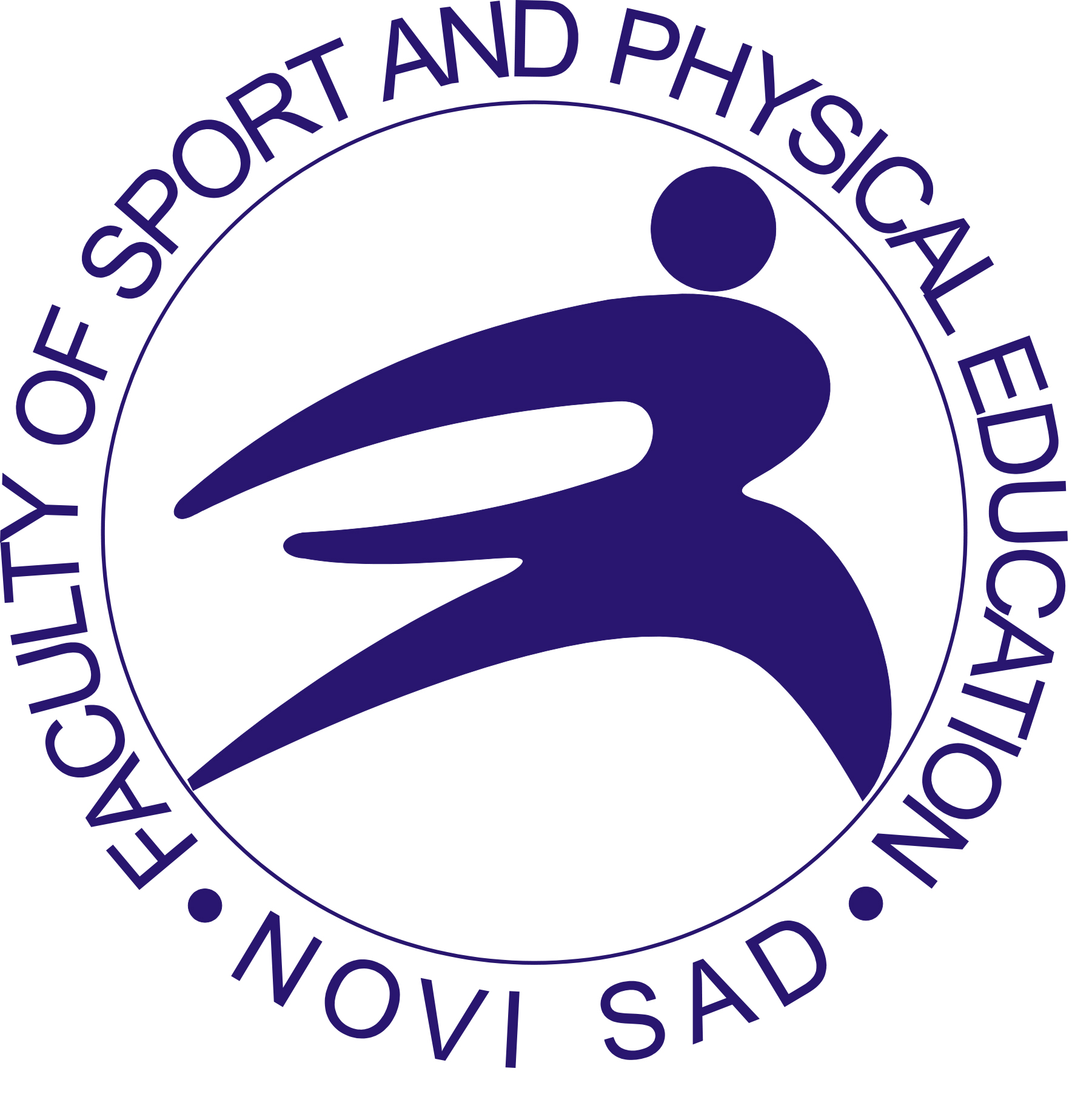Current issue

Volume 17, Issue 1, 2025
Online ISSN: 2406-1379
ISSN: 1821-3480
Volume 17 , Issue 1, (2025)
Published: 15.06.2025.
Open Access
All issues
Contents
20.06.2023.
Original scientific paper
Influence of health status and loneliness on satisfaction with life, emotional dimensions, and distress in junior handball players
This transversal study aimed to examine the contribution of predictor variables of the construct of health status (objective and subjective assessment of health) to the variability of the criteria satisfaction with life, emotional dimensions (positive affect, negative affect), and emotional factor of distress (depression, anxiety, and stress) in junior handball players. The pertinent sample consisted of 132 junior handball players in – Serbian First League. The average age of participants was 18.25 ± 0.90 years of age. The following measuring instruments were used: 1) the Depression, Anxiety, and Stress Scale – DASS-21, 2) De Jong Gierveld Loneliness Scale – DJGLS, 3) the Satisfaction with Life Scale‒ SWLS, and 4) The Positive and Negative Affect Schedule – PANAS showed satisfactory internal consistency. The conducted multiple regression analysis explained 51% of the proportion variance of the dependent variable satisfaction with life, positive and/or negative affectivity, and cognitive aspect of distress, where the only statistically significant negative predictors were loneliness and subjective assessment of health status. At the same time, when it comes to the assessment of loneliness in adolescents, these independent variables achieved significant interaction with the subjective assessment of health. This would mean that handball players, who subjectively assess their health as bad, and feel lonelier. On the other hand, the regression model did not confirm the role of the predictor variable objective assessment of health status and loneliness. This regression study has contributed to the existing literature and empirical data on the significance of the rarely explored relations between the constructs of health and well-being in the adolescent sports population. Theoretical contributions and practical implications for future research were also discussed.
Miroljub Ivanović, Uglješa Ivanović
14.06.2022.
Original scientific paper
The relations between body mass index, motor skills, and physical self-concept in determining physical activities of junior karatekas
The aim of this research was to examine the contribution of body mass index (BMI), motor skills and physical self-concept in explaining the physical activity (PA) of adolescent karatekas (N=148). The average age of participants was 16,56 years (± 1,14). The following measuring instruments were used: Body Mass Index (BMI), Eurofit Physical Fitness Test Battery, Physical Self-Description Questionnaire (PSDQ), and Physical Activity Questionnaire for Adolescents (PAQ-A). The Cronbach's alpha coefficient was used to determine the internal consistency of the questionnaires. The results of the hierarchical analysis showed that the predictor variables explained 18,5% of the total variance of the criterion PA of junior karatekas. With their positive direction, the independent variables of the physical self-concept strength (β = 0.049; p < 0.01), flexibility (β = 0.037; p < 0.01) and self-respect (β = 0.019; p< 0.05) showed the maximum statistically significant contribution to predicting the variability of the participants' PA, which means that junior karatekas who manifest the higher level of perception on those variables exhibit the higher level of PA. This study confirmed that the applied instruments are valid and suitable to predict PA among adolescent athletes in Serbia.
Miroljub Ivanović, Uglješa Ivanović
15.06.2018.
Original scientific paper
Gender differences during adolescence in the motives for physical exercise, depression, anxiety and stress
Lately, there has been increase of interest in examining the motives of male and female adolescents for taking part in physical activities, as well as examining their depression, anxiety and stress. The objective of this paper was to investigate intergender differences between male and female adolescents concerning the motives for physical exercise, depression, anxiety and stress. The pertinent sample accounted for 332 high-school students of both sexes from Valjevo (164 females and 168 male high school seniors), aged 18.10 ± 0.86. Three measuring instruments were used: Questionnaire for collecting basic data, The Exercise Motivation Inventory 2 („EMI–2“) questionnaire and the Depression anxiety stress scale (DASS – 21). The internal consistency and reliability of the questionnaire and the scale was satisfactory. The given results revealed that there are statistically significant gender differences, as the male adolescents, compared to the female adolescents, more frequently took part in physical activities (p ≤ 0.01). The important difference between the motives for participating in physical activities between the male and female participants was defined, so the motives: Socializing, Competition, Enjoyment, Social recognition and Strength and Persistence were more dominant with male adolescents, whereas motives: Appearance, Agility, Maintaining and improving health, and Body mass control were manifested more with female high school seniors. The findings revealed, with the probability of error being 0.05 the statistically significant differences of the depression dimension between the adolescents who rarely or never take part in physical activities and those who take part in physical activities three or more times a week. The results suggest that there are significant differences between male and female participants when it comes to stress variable (t = -2.47, p ≤ 0.01) and anxiety variable (t = -2.17, p ≤ 0.05). Differences on the depression variable are not significant. The findings were discussed within the context of current empirical and theoretical frame.
Miroljub Ivanović, Uglješa Ivanović
15.12.2018.
Original scientific paper
Prediction of mental health among cadet football players based on the emotional intelligence and perfectionism
The aim of this research was to examine in which way the constructs of emotional intelligence and perfectionism predict mental health of adolescent football layers. The sample consisted of 164 participants (average age 16.63 (± 10,21) years). The research was conducted in April 2018 and it included the cadet football players from KolubaraMacva league in Serbia. Test of Emotional Management (TUE; Babić-Čikeš i Buško, 2014), Multidimensional Perfectionism Scale (MPS; Frost et al. 1990) and Mental Health Inventory (MHI-38; Veit & Ware, 1983) were used to generalize data. During the process of data analysis, metric characteristics of the measuring instruments were first tested using the method of internal consistency which was based on Cronbach's alpha coefficient. The empirical findings of the correlation analysis revealed that there is no link between emotional intelligence and mental health of football players, meaning that managing emotions is only linked to adaptive dimensions of perfectionism (p ≤ 0,01). The obtained coefficient of multiple determination (R = 0.27) indicated that the group of predictors accounted for 27% of the variance of mental health, meaning that the perception of non-adaptive traits of perfectionism: (a) worry about mistakes, (b) dilemmas regarding one’s own actions and (c) parental criticism contribute the higher number of mental health problems. In addition, it showed that the adaptive trait of perfectionism (organizational skills) directly contributes better mental health of cadet football player. The results of this study suggest that the variables of emotional intelligence and perfectionism have significant role in prediction mental health among adolescent football players.
Miroljub Ivanović, Uglješa Ivanović























